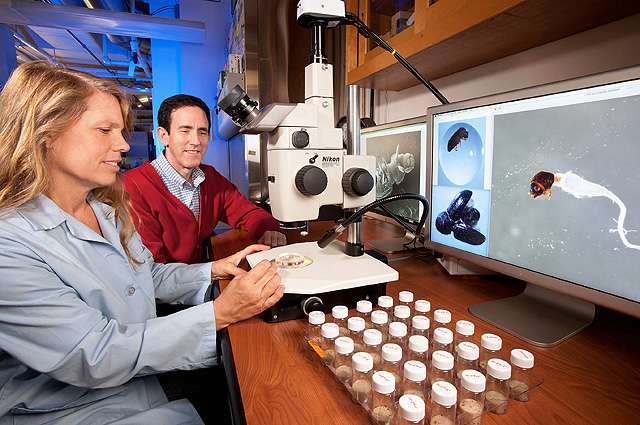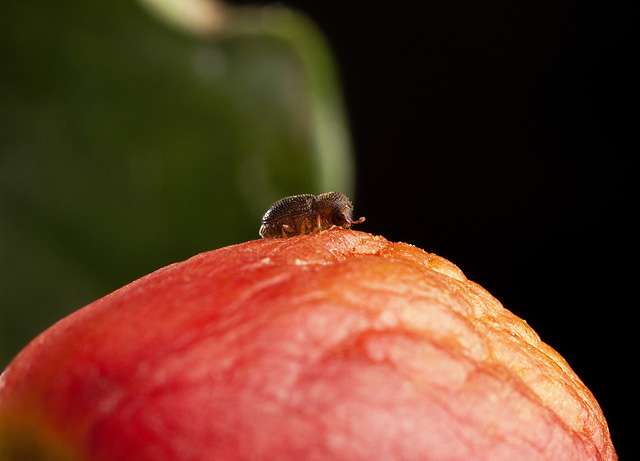How coffee berry borers survive on caffeine

The world's most devastating coffee pest can cut yields by up to 80 percent, and it survives on what would be a toxic dose of caffeine for any other insect. Some 850 insects can feed on different parts of a coffee plant, but only the coffee berry borer (Hypothenemus hampei) feeds on the bean itself—and feeds exclusively on it.
Fernando E. Vega, an Agricultural Research Service entomologist in Beltsville, Maryland, and his colleagues Javier Ceja-Navarro and Eoin Brodie, who are with the U.S. Department of Energy's Lawrence Berkeley National Laboratory, have discovered what enables the coffee berry borer to survive on such a lethal diet: the bacteria in its gut. The findings are good news for coffee drinkers. They provide a new target for developing strategies to manage a global pest that in Brazil alone costs growers up to $315 million each year.
"This opens a door to potentially new pest management strategies, and it adds to a growing body of research showing how a wide range of organisms, from insects to humans, use their internal microbial profiles to adapt and survive," Vega says.
Most of the coffee consumed in the United States is imported (Hawaii and Puerto Rico produce some). But ensuring a sufficient supply of high-quality beans has U.S. implications beyond Hawaii and Puerto Rico. Coffee generates $46 billion in U.S. sales each year in supermarkets, restaurants, and shops, and an estimated 78 percent of U.S. adults drink coffee, at least occasionally.
Vega and his colleagues analyzed coffee berry borers from seven coffee-producing regions: Guatemala, Hawaii, India, Indonesia, Kenya, Mexico, and Puerto Rico, as well as from Vega's laboratory-reared colony in Beltsville. They removed the digestive tracts from the tiny beetles, a painstaking process, and then placed the mashed-up digestive tracts in a caffeine-rich medium to see which bacteria would grow in it. That way, only the bacteria that degraded caffeine would survive. They found 14 bacterial species that degraded and detoxified caffeine. Most of those bacteria were in beetles from all seven coffee-producing regions, and one bacterial species, Pseudomonas fulva, was the most prevalent.

To confirm that the bacteria degrade caffeine, they gave the beetles an antibiotic to wipe out the bacteria and fed those beetles a standardized diet of coffee beans. They found that the caffeine passed through the beetles' digestive tracts intact, without degrading. Though the beetles survived, their capability to produce eggs and larvae declined by 95 percent. The scientists next added the caffeine-digesting P. fulva bacteria back into the beetles' diet and found that their feces were devoid of caffeine, which showed that the bacteria are key to the detoxification process.
The study, published in Nature Communications (July 2015), was the first to explore the gut contents of the coffee berry borer. The research was funded by the U.S. Department of Agriculture and the Berkeley laboratory.
A team led by Vega also recently published a study in Scientific Reports (July 2015) mapping the coffee berry borer's genome. Taken together, results of the studies could potentially lead to new pest management strategies.
More information: Javier A. Ceja-Navarro et al. Gut microbiota mediate caffeine detoxification in the primary insect pest of coffee, Nature Communications (2015). DOI: 10.1038/ncomms8618
Journal information: Scientific Reports , Nature Communications
Provided by Agricultural Research Service

















